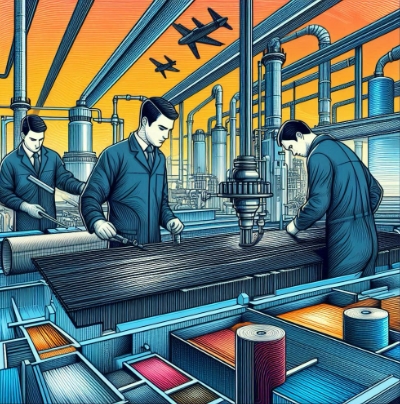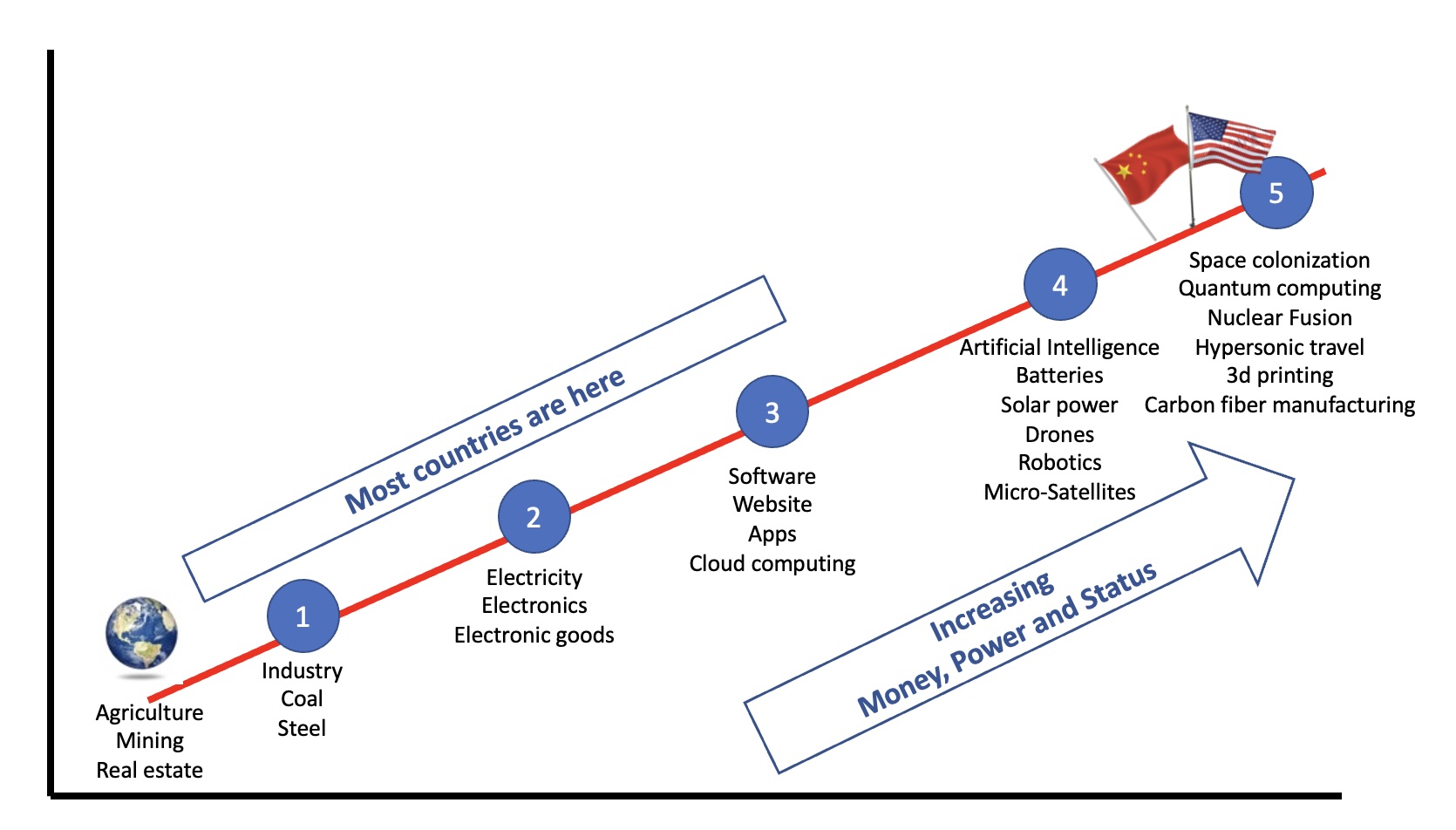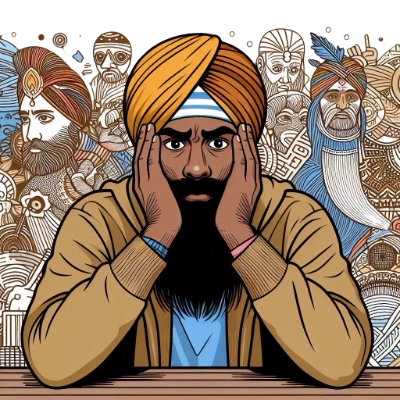 We were all hunter-gatherers thousands of years ago. Then humans discovered farming, bronze, and iron. It gave rise to Bronze Age and Iron age.
We were all hunter-gatherers thousands of years ago. Then humans discovered farming, bronze, and iron. It gave rise to Bronze Age and Iron age.Industrial Revolutions
Bronze Age and Iron age led to the First Industrial Revolution. Coal and Iron were in use before. But it was only during the First Industrial Revolution that they were put to use at scale. Almost all aspects of life were transformed: agriculture, clothes, transport, work etc. Work patterns, living standards, and culture was also transformed. People moved from the villages to the countryside.Encyclopedia Britannica describes the changes from the First Industrial Revolution as "technological, socioeconomic, and cultural". (Britannica, 2024). There were new machines, jobs in factories and industries, development of urban life, and new mindset.
Second Industrial Revolution was primarily driven by use of electricity and electric goods (industrial and home appliances) at scale. We got air conditioners, refrigerators, washing machine, lights at night, radio and TV etc.
Third Industrial Revolution was driven by Information Technology: computers, internet, smartphones, apps, and cloud computing at scale. We got internet, electronic media, youtube, social media, food delivery apps, ride sharing apps, maps on the phone, video calls.
We are now in the Fourth Industrial Revolution. This is driven by Artificial Intelligence (AI), drones, solar, battery technology for large scale storage, robotics, micro-satellites (e.g. Starlink, satellite communication capabilities in consumer smartphones).
The Fifth Industrial Revolution will be driven by space travel and space colonization, hypersonic travel, quantum computing, nuclear fusion, carbon fiber manufacturing, and 3D printing.
With each new industrial revolution, money, power, and status increases exponentially. As an example, the First World War was fought with cavalry on horses and soldiers in trenches. Such an army would have been slaughtered in the Second World War. Armies fighting like it is the last war will be slaughtered.

Industrial Revolutions and War
General David Petraeus, who commanded the US-led coalitions in Iraq, and former CIA director; and the British historian Prof. Andrew Roberts, Baron Roberts of Belgravia, and Member of the House of Lords write it the book “Conflict: The Evolution of Warfare from 1945 to Ukraine” that the nature of war has changed. No longer can armies fight with just guns, artillery, tanks, aeroplanes, bombs, and soldiers.Wars are now Hybrid wars - "grey-zone war, asymmetric warfare, non-linear warfare".
Hybrid warfare is "use of unconventional or asymmetric methods of war that stretch across subjects, arenas and domains of warfare". It involves "Proxies, economic warfare, targeted disinformation, political manipulation and covert military action".
As part of Ukraine-Russia conflict, the authors describe the reality of hybrid warfare.
“Russia’s malware attack on Ukraine prior to the seizure of Crimea in 2014 had stalled a fifth of the world’s shipping capacity.” “Ukrainian air defense radar was jammed across all frequency bands.”
“Data analytics company Palantir supplied software that translates up-to-the-second information from satellites, drones, spies’ mobile phones and sensors into a model that allowed highly accurate rocket and artillery strikes.”
“Ukraine also remained connected to the internet in part due to the Starlink mobile satellite terminals.” “GIS Arta, a computer system developed by Ukrainian programmers in collaboration with British digital mapping companies, cut targeting times from twenty minutes to one, and led to the destruction of more than seventy Russian tanks, armored fighting vehicles and personnel carriers in two days of coordinated shelling and airstrikes as they attempted to cross a bridge over the Siverskyi Donets River in eastern Ukraine.”
The authors also stress the “significance of highly professional non-commissioned officers and the importance of contesting the information sphere” - the human element still is critical.
Wars are about more than training, discipline, co-ordination, valor; and artillery, tanks, ammunition, bombs, and aircraft. We still need all that. We also need professionals trained in information warfare, AI powered cyber warfare and cyber defense, dis-information, economic war, political manipulation.
Beyond War
Moving away from warfare, no person, organization, corporation, nation can continue to be a generation behind and expect to thrive in any aspect of modern life.The founder of the Silicon Valley Venture Capital firm Andreessen Horowitz said “Software is eating the world”. Software took over many tasks. E.g. software on our phones ate the market for physical maps, cameras, CD’s, bank statements, physical mail, printers, travel agents etc.
The products of Third Industrial revolution (smartphones, apps) ate market of those before it.
The companies that adopted the newer technology thrive, while those who don’t fall behind. It is just Darwinism.
You can still be a millionaire and own a multi-million-dollar company in real-estate, agriculture, oil and gas, shipping etc.
You can still be a millionaire and own a multi-million-dollar company making software for local government or for a bank.
But the billionaires running multi-billion- and trillion-dollar companies are churning out products of 3rd, 4th, and 5th industrial revolution.
Comfortable existence, high-level equilibrium trap, cruising on past accomplishments will lead us to fall behind. There is disruptive innovation in every sector including warfare, agriculture, oil and gas, transport, shipping, logistics, graphic design, and even software development.
Taking part in the 3rd, 4th, and 5th industrial revolution is a way for people, corporations and nations to get out of the middle-income trap. Middle income trap is an economic term used for people, corporations, and nations which achieve middle class level of income and then plateau, while the world races ahead.
Asian Development Bank says that “Insufficient development of domestic innovation capabilities is at the heart of the middle-income trap.” (Asian Development Bank, Escaping the Middle-Income Trap: Innovate or Perish, 2017).
Entities sometimes try to fight change and try to find ways to maintain the status quo. Many cities ban or restrict ride sharing apps and peer to peer house rental apps. They become irrelevant and in middle income trap while the world surges ahead.
Think in Fifth Industrial Revolution terms
An example is public transport travel cards. Most big cities offer physical cards for travel on public transport. They are sold in shops. People line up to get them, and then line up to get refund when they no longer want the card.Thinking in traditional bricks-and-mortar terms involves a shop to sell cards, a customer service representative to sell them, a physical factory to print them, logistics to transport the cards.
A 3rd industrial revolution approach involves a QR code to add the virtual card to smartphone wallet and do it all online.
The engineers building 3rd industrial revolution infrastructure generally get better pay, the customer service representatives also feel proud to work in a modern software company rather than a small shop. It is also good for the environment and congestion as no factories or physical transport or lining up in train stations is required.
A visitor to that country will immediately know without a word being said that the country has their act together. Traditional brick-and-mortar infrastructure with lines of people impresses no one.
Physical card can be offered as an alternative for the small minority that don’t or won’t or can’t use smartphone wallets and virtual cards.
Industrial revolutions as prosperity and power multipliers
The lesson here for prosperity is that people, corporations, organizations, and nations need to participate in new industrial revolutions, or risk becoming irrelevant, stay in middle income trap, and lose wars while the world surges ahead.It is no coincidence that only USA – and no one else - is master and innovator of third, fourth, and fifth industrial revolution at scale. All other nations still think and act in terms of old way of doing things, and still prepare to ‘fight the last war’. At best, they can copy well.
It is no coincidence that the highest paid jobs are for AI engineers in the Silicon Valley with $600,000/year for AI engineers, and $900,000/year for experienced AI engineers while those with mechanical, civil engineering degree, and sociology majors struggle to get $60-90k/year.
It is no coincidence that Hilton Hotels market capitalization with 7500 hotels worldwide is $50 billion; while Airbnb market capitalization is $100 billion without owning any property. Similarly, market cap of Ford Motor Co is $52 billion, market cap/sale price of the old agriculture giant Monsanto was $60 billion, while market cap of Nvidia is $2 trillion.
"It is being realized with a thud that the world is probably going to be ruled by those who know how, in the fullest sense, to apply science." (Vannevar Bush).
Comfortable existence, high-level equilibrium trap, cruising on past accomplishments is a path to falling income, middle income trap, declining social status, and eventual irrelevance.
People, organizations, corporations, and nations will see decline in wealth, quality of life, power, and social status unless they are participating in the 3rd, 4th, and 5th industrial revolution at scale.
3rd, 4th, and 5th industrial revolutions are prosperity multipliers.

